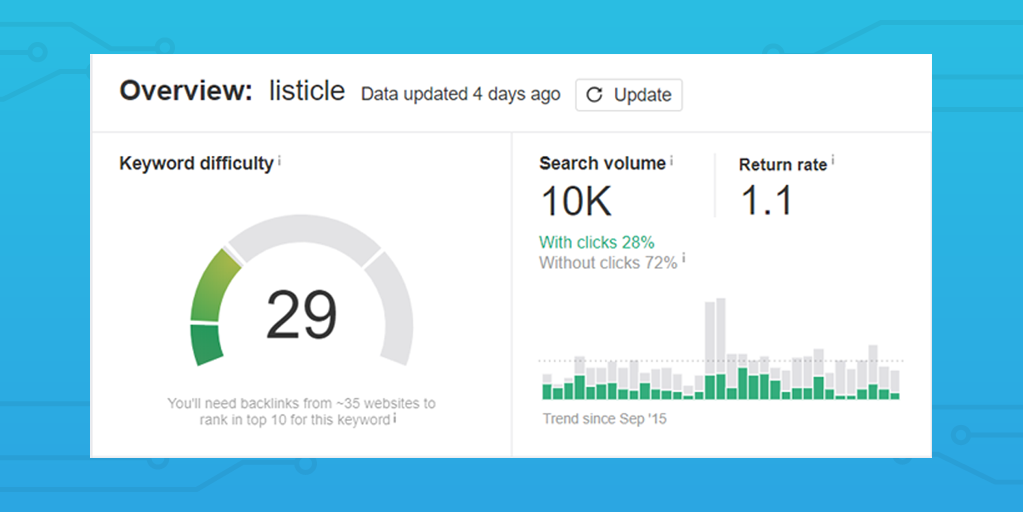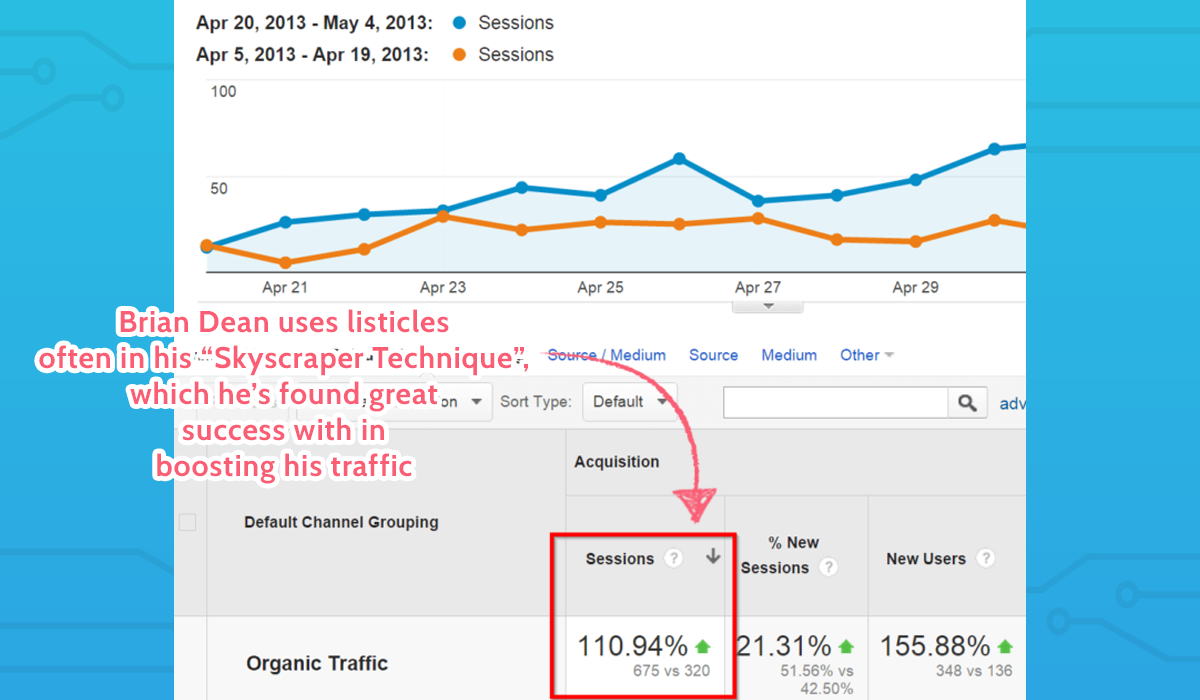
One problem dominates the field when setting out to write a listicle.
They’ve been done to death, and a lot of us are sick of them.
From Buzzfeed and the Huffington Post to Bustle and beyond, thousands of lists are published every year, the majority of which are not exactly high-quality.
People see lists and have been trained to think “clickbait”. That’s what this post will help to avoid and prevent.
Read on to find out:
- What a “listicle” is
- Why they are so popular (to read and write)
- How to plan a listicle in 6 steps
- How to write a listicle in 5 steps
Enough talk – let’s get to it.
What are “listicles”?
A “listicle” is an article made of a list, usually with some kind of extra detail to each item.
The format, however, is flexible. You could write a listicle which is nothing more than a title, five sub-headings for each list item, and a picture or gif below each.
On the other hand, listicles can be used as a framework to make a complicated topic easier to understand.
The subject you write about can be literally anything. Even if there isn’t a list which naturally fits a given topic, you can create one by looking at the subject with a certain angle.
For example:
- The 7 Stages of Grief by Recover from Grief – a standard formal listicle, with an introduction explaining the topic, a list of items living up to the promise of the title, and just enough detail to succinctly explain each item.
- The Three Stages of Refining by Planete Energies – a long-form essay-style listicle with fewer items and longer explanations for each. It also shows that listicles don’t always have to be numbered.
- 23 People You Seriously Won’t Believe Actually Exist by Dave Stopera – the most widespread type of listicle and the most widely disliked. The article is entirely subheaders and accompanying images with outlandish promises used in the title – practically a trademark of Buzzfeed‘s articles at this point, and what many would negatively consider to be “clickbait”.
- 9 Property Management Checklists to Keep Your Rental Processes on Track by Alex Gallia – one of our own listicles, serving as a collection of related items (templates) instead of an explanation of a topic.
- Best Customer Feedback Tools For 2021 by Qualaroo – an example of customer-focused content which is brand-led and provides an easily digestible way to learn more about products or services.
There is an almost unlimited number of ways in which you can use listicles to make your argument, explain a topic, sell a product, and so on, but I feel like that’s enough to get the basic idea.
Why are they so popular?
Listicles work for many of the same reasons that traditional lists do – we just like to read them.
Lists (and listicles) are great to read because:
- The title tells you what to expect
- They’re easy to skim for important information
- You always know how much is left
- It’s easy to put down and come back where you left off
- They can break complex topics down into digestible chunks
With titles like “How to Keep Hair From Getting Greasy” you know exactly what you’re going to get and whether the article will be useful to you. Quality of the article aside, it’s a great way to know that you aren’t going to waste your time reading an irrelevant discussion of a similar topic.

To save even more time, many (myself included) like to skim-read articles to get the important information without having to read the whole thing. Listicles are perfect for this, since the main points are often expressed in either obvious sub-headings or bullet-pointed lists which are easy to spot and read at a glance.
Then there’s the mental aspect of listicles; it’s similar to the psychological effect of having a checklist or task list. There’s an inherent sense of progress and accomplishment as you work your way through the piece, which itself encourages you to finish reading.
As for why they are so popular to produce, there are a few reasons (aside from their popularity with audiences):
- They’re easy to plan and write
- Each item written feels like an achievement
- Lists are great for targeting core keywords
- Smaller listicles can be adapted to suit long-tail keywords
- Updates are easier to make
Listicles are easier to plan and write than traditional articles because they don’t have to worry so much about the order of their points.
Sometimes a particular order might be more effective but, in general, any extra items can be added to the end of the list without disrupting what’s already there. This makes it easy to slot in new points without having to restructure what’s already there.
This is the same reason why updates are easy to make. If a new point needs adding you can just slot it at the end of the current list and change the title. If an existing point needs changing, the format will make it easy to find and tweak.
However, just because they’re easy to read and write doesn’t mean you can be lazy with your content and expect to get away with it. Audiences have been exposed to so many listicles at this point that you can easily run the risk of being seen as producing clickbait or worthless drivel.
The key to avoiding this is knowing how to properly plan and write your content.
How to plan a listicle

Planning a listicle involves six steps:
- Choose your topic
- Select a keyword (if necessary)
- Search your competition
- Choose a unique angle
- Write the list points
- Decide on accompanying material
1. Choose your topic
First, you need to choose your topic. This can be anything you like and will largely depend on why you’re writing the article.
If you’re writing on your personal blog it could be a topic that you’ve wanted to tackle for a while. A business blog (such as the one here at Process Street) may instead use a topic relevant to their product’s audience.
Whatever you choose, it’s worth creating a document in your writing app and taking notes on your choice. If possible, it’s also a good idea to record what the purpose of the article is, as this can help you decide what angle you’re going to tackle the topic from.
2. Select a keyword (if necessary)

Next, you should find the right keyword for your post. This is only really important to content designed to get a lot of (or more frequent) readers; if you’re writing for fun, don’t worry about this.
Keywords are essentially the words that search engines associate your article with. Then, if someone searches the relevant term, your article will be marked as relevant and have a chance to be put higher up the search results.
Higher ranking for a keyword means your content it closer to being the first result for that term. The closer you are to first place, the more people will read your content.
There are some fantastic tools out there to help with your keyword research, such as Google Keyword Planner and Ahrefs. Use these to find a keyword with a decent amount of traffic (volume) and as low a difficulty rating as possible (to make it easier to rank for).
If you need help, check out our free SEO and keyword research process.
Listicles are also great for targeting the long-tail of a keyword, as they’re easy to write and read. You could even create a landing page to target a main keyword and then use it to link to a collection of listicles which target all of the long-tail variations of that keyword.
3. Search your competition
Once you’ve selected your keyword (if at all) the next step is to look up your competition for the topic. That is, search your keyword or topic in Google and see what results are currently top-ranking.
By checking these results you can see both the type of information your audience is looking for when they look up the topic and what quantity and quality of information you’ll have to surpass to get significant traffic.
In other words, if everyone else has lists or articles containing no more than 10 points, you need to aim for 15 or 20 to have an advantage.

Having said that, you shouldn’t add new points for the sake of it. If there are indeed only 10 significant points to make, consider going into more detail, having a more scannable structure, or even adding bonuses to make your piece stronger than the competition.
Irregular numbers are also more eye-catching than standard figures like 15 or 20. Lists of 19 or 23 are more unexpected, and so are a little more intriguing for potential readers.
Whatever you decide to do to beat your competitors, note it down in your plan along with the rough information, number of points, and level of detail in other posts. That way you don’t have to keep looking them up to know what you need to aim for and surpass.
4. Choose a unique angle
It’s time to choose a unique angle to tackle the listicle from. This is a great opportunity to use what you’ve learned about your competition and what you already know personally about the topic.
The angle needs to provide value that nobody else can; otherwise, your post could be easily eclipsed by someone taking what you’ve written, adding their own expertise, and not even having to reference you.
If your information isn’t in some way unique to your own post, there’s also little reason to link back to you instead of your sources. Not to mention that your audience may well have heard everything you have to say before and quickly bounce from your page.
To give you some ideas of unique angles, you could:
- Write from personal experience on the topic
- Use an interesting example/case study to frame the information
- Dig out obscure but useful statistics to shed new light on the topic’s importance
- Give relevant content upgrades to encourage further action and provide extra value
- Collect information from multiple sources to provide a summary
The last method (collecting information) isn’t the ideal way to frame a listicle as literally anyone can look up a few sources and provide a summary – there’s nothing unique about the information itself. However, if you can’t do anything else then it’s better than nothing.
Under no circumstances should you just take what the current top-ranking post has said and turn it into a list. Not only will you have to heavily reference that post in your work to avoid plagiarism (which will only make its ranking stronger), but there is literally no reason for someone to read yours instead of what’s already ranking.
5. Write the list points

It’s time to plan the meat of the article – the list itself.
Go ahead and plan out the number of points identified when looking up your competition. Don’t worry about the order of your list just yet (or any detail for the points you make).
Get the list written in its base form, make sure you’ve covered everything you want to, and look up information from existing sources if needs be.
Quick note; it’s always best to try to find the original source of your information to link back to rather than using a second-hand source. Not only do you get a sense of how reliable the info is but this can also avoid giving backlinks to your competition.
If your sources have citations, follow them until there are no more links to follow. If there’s no citation but there’s a reference to the source (eg, “from a 2016 study”) try entering the information into Google along with the rough source. Even if you can’t locate it, it’s good to get into the habit of trying.
6. Decide on accompanying material
Finally, decide on the level of detail that will accompany your list and whether any extra material (eg, content upgrades) will be provided.
This will largely depend on how much information you have on each point, along with what your competitors have already published.
If everyone else has included minimal detail in their post, you can probably get away with writing only a paragraph or so for each point. If they’ve gone into detail, consider topping that with a content upgrade to sweeten the deal.
How to write a listicle
You’ve now got a solid plan, and it’s time to write your listicle.
To do this, you need to:
- Choose your listicle type
- Stay away from clickbait titles
- Be specific
- Use images and/or gifs to illustrate your points
- Have a solid conclusion
1. Choose your listicle type

First, you need to choose what type of listicle you’re going to write. This will mostly depend on what you feel suits your topic best, and what you think will be ideal for covering the points you want to in the most direct and interesting way.
While there aren’t any real set formats for your list article, the rough categories are:
- A personal essay/experience-based listicle (X things I learned about Y)
- Advice from experience (X tips from 3 years of working remotely)
- Research roundup (a heavily sourced list of information)
- Reported list (more of an article turned into a list to make it scannable)
- Editorial-turned-list (a list being used to argue a specific point)
Each has a different appeal and it’s up to you to decide which best suits your goals with the article, along with what you can provide in terms of the angle you approach it from.
Once you’ve decided, it’s time to move on to the title of the article.
2. Stay away from clickbait titles
Clickbait is difficult to avoid, as it encompasses different things for each reader.
In general, clickbait can be taken as something which uses its title to promise something unrealistic or plain doesn’t follow up on what its title claims to do.
For example, unrealistic claims could be:
- 36 Inventions You Won’t Believe Exist
- 13 Tips to Solve Any Problem For Good
- 16 Amazing Recipes to Convert Your Friends to Veganism
As long as you stay away from making bold claims which are completely (or even mostly) impossible to meet, you should be fine. That is, as long as any claims you make are actually met within the body of the article.
Speaking of which, it’s time to move on to actually writing your listicle.
3. Be specific
Lists are a perfect medium for giving value without any fluff. While this helps, you also need to make a conscious effort to be as specific as possible with each item.
This advice holds true for most blogging and article writing in general; the key is doing it consciously until it becomes a habit.
The best way to make sure that you do this and cut any meandering in your work is to put an extra check in your pre-publish checklist. Add a step to check for filler words and remove them.
If you don’t have one already set up, check out our free blog pre-publish checklist for a handy checklist to get you started.
4. Use images and/or gifs to illustrate your points
Lists by themselves can be pretty dull. Even the most dedicated of readers can quickly zone out if there’s nothing but text to occupy their attention.
That’s why you need to include relevant images and/or gifs to add some flavor to your listicle. Don’t spam them if they’re not required, but try to break up the post so that you have around one image per page of text scrolling.
The same can be said for regular articles – we here at Process Street use this very tactic. By making sure that your readers always have at least a portion of an image on screen you can help to encourage them to scroll further to see the rest.
Whatever you decide to use, make sure you have the appropriate permission levels to use it. For help on that, check out the following post:
5. Have a solid conclusion
Most of the value of listicles comes from the list itself. After reading that, most people will want to close the article and get on with their day.
That doesn’t mean you should skimp on the conclusion.
Most listicles (and articles in general) have lackluster conclusions which either summarize what’s already been said or give a short sentence with vague comments. Heck, I’m guilty of doing the same thing from time to time.
Instead, try to use the conclusion to do something extra. Here are a few ideas:
- Give unique examples of your topic to inspire experimentation
- Tie everything back to your central argument and hammer the point home
- Offer a content upgrade or have another call to action
- Suggest activities or techniques to use what you’ve written about
Listicles aren’t just easy content

While this post has shown you how to write a basic listicle, that doesn’t mean every list has to be short or easy. With a little more effort and planning, you can thoroughly dominate search rankings with advanced list-based techniques.
One of the best examples of this is Brian Dean‘s skyscraper technique. This involved a formulaic approach to looking at a keyword’s competition, then crafting content which was better and having a set outreach plan.
Once again, this is easier to achieve with a list (where appropriate) because of how easy they are to write and update.
Don’t believe me? Well, with this method he was able to increase his search traffic by 110% in just 14 days.
Still, whether you go for gold or just want to create an engaging list post that doesn’t stink of clickbait, you now have everything you need to know to get started.
What do you think of listicles? Are they nothing but clickbait? Let me know what you think in the comments below!







Ben Mulholland
Ben Mulholland is an Editor at Process Street, and winds down with a casual article or two on Mulholland Writing. Find him on Twitter here.